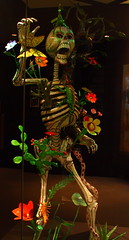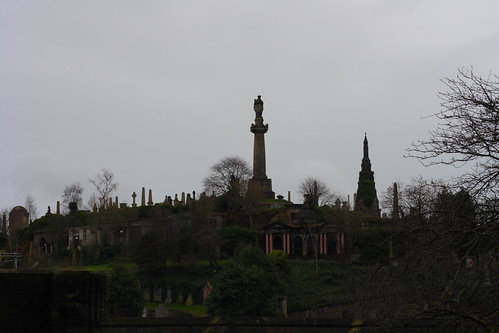One thing you can say for upping the intensity of a workout is that for the next several weeks, you are JUST. wiped. out. We kept thinking of all of these great places we should go, but sadly, the things that sounded best were places with masseuses and full-time staff feeding us grapes and letting us sleep… In lieu of visiting any of those pricey places, and in realization of the fact that Spring seems to be reversing at a hundred miles an hour into a repeat of winter (snow + 40 mph wind + thunder and lightning= ??!!?), we decided to still go on an outing, but stick close to home so we could race back and get warm and dry as needed (That was a wise choice for yesterday, since today it’s SNOWING. The forecaster lady says there are “floodies,” by which we understood, after a few dazed moments of listening, that there are flurries). It’s cringe-inducing, but there are still places within the city we haven’t managed to get to — and the Glasgow Cathedral — the oldest building in the whole city — was one of them.
The Glasgow Cathedral‘s name is a strange thing, considering that it is something like four separate churches, all intertwined and built on top of one another (literally), and there’s no bishop, which means it’s not really a cathedral at all. An excerpt from Undiscovered Scotland’s page explains it best (original here):
The site on which the cathedral was built slopes down from west to east. This allowed the building of its most unique feature, a lower church effectively occupying the whole of the area under the choir. This is a beautifully vaulted space. At its heart lies the tomb of St Kentigern or St Mungo, while at its east end are a series of chapels.
These include the Chapel of St John the Evangelist, still containing part of what is believed to be the well used by St Kentigern in the late 500s. These chapels were particularly well used after 1451, when the Pope declared that a pilgrimage to Glasgow Cathedral would carry the same merit as one to Rome. In the same year he approved the foundation by the cathedral of the University of Glasgow.
Whoa. Imagine: the same merit as a visit to Rome… and it’s not a Catholic church. So, you kind of get an idea of the pomp and circumstances.
As you enter the church nave, the first thing you notice (aside from the guest book you’re urged toward, and the inevitable little postcard shop by the front door) is the immense arch of the ceiling. You can imagine …sound. Choirs, soloists, arias. We didn’t get to hear the organ — we’re going to have to make a point of coming back when there is a service — so we couldn’t really get a feeling for the acoustics, but it’s a strangely live space, rather than being filled with echoes. It has the reverberation one expects from great, vaulted ceilings, but is more muted, as if the sound would not simply echo about forever.
As with many of the state churches here in Scotland, much of the space is dedicated to the dead, with monuments every few feet along the walls, and with the stained glass windows having been dedicated by someone’s family, or by one of the branches of the Armed Services. It’s a bit strange, to us, to encounter stained glass windows commemorating the battles of four hundred years past through to the battles of the last decade. In wondering about that, and about the overwhelming presence of military memorials, we had to remember that the UK has a monarch who is simultaneously the primate of the Churches of England and Scotland Governor of the Church of England (see Usually Harmless’ note in the comments, below), and commander of the military. There is an official state religion, here. So … there is no “separation of church and state.” This is a truly fundamental difference, between our countries. I don’t think that we’ve understood how different we are, really.
Not that there’s anything at all inappropriate about memorializing war deaths in a church. But it would seem strange to us to have a stained glass window of the logo of the United States Air Force or something like that. The military falls into that side of the formula which is “state,” rather than “church.” It’s subtle, perhaps, more so in the past few years, but it’s definitely a division. It was weird to confront that over and over again.
Anyway – after we spent an awestruck twenty minutes in the main area, photographing the clock and all the stained glass windows (do not miss the Millennium Window on the north wall — you have to understand that T. worked at a stained glass factory in high school, so she’s a little unhinged over stained glass), we meandered up to the quire to look at the first of the old chapels. On the wall were regimental colors from before WWI — a Union Jack with a…lizard? dragon? squarely in the middle. The fabric has disintegrated through time, despite being under glass and in a very dim room. We were disappointed to find no further information about it.
As always, there were the symbols from the Glasgow crest — a bird, a tree, a fish and a bell. It’s… kind of like a riddle, and we don’t really get it, but there’s a whole legend behind “the bird that never flew, the tree that never grew, the fish that never swam, the bell than never rang.” We figure it can’t be any more obscure than the reasons we have a bear on our flag…
Going down into the bowels of the church was really interesting. There’s an old well down there — capped, of course, but it was used in the 500’s by the church folks. Apparently if you have a saint attached to a well, it’s… well, holy water. Being in the very bottom of an old stone church in the winter means it’s freezing cold, but it was worth it to see the pre-Reformation gothic architecture from the 1100’s through the 1600’s still alive and well and preserved. We loved the swoopy ceilings in the Blacadder Aisle, and mostly refrained from thinking how much the white plastered ribs looked like bones…
There is so much within this place which is beautiful, yet so much which is about death: empty armor, knightly regalia, tattered battle standards, right down to the underchapels with an assortment of burial plaques in the floor and stone coffins, one of which contains St. Mungo himself, covered with a gorgeously woven altar cloth. It is perhaps fitting that the Necropolis is simply an easy walk down a hill and across a stone bridge over a river.
What’s also just across the parking lot is the St. Mungo Museum of Religious Life. After the drafty and cold cathedral, this place was a treat. Lights! Electric heat! Unfortunately, it is staffed by people wrapped up in cardigans who are apparently freezing; it must have been eight-five degrees in there! We went up to the third floor, and started our religious education from the top down, thanks to the timely advice of a passing coffee shop worker. Small kiosks inform about Sikhism, Sufism, Hinduism, and any other -ism you can find. We were amused by all of the old-timey displays, including a Billy Graham song book and some lugubrious looking penny banks, with puppy-eyed children looking sad, who were supposed to represent the poor back in the 1800’s. (Nowadays, the poor look just like everybody else!)
We have to admit that because of the heat, we really raced through this museum (to sit out and subsequently freeze at the bus stop), but we very much recommend it, especially the middle and the bottom floor, which contain gorgeous examples of religious art, including Persian figural calligraphy, and the icons of ceremony, including wedding dresses, christening gowns, death masks, and the like for various cultures. There is an amazing papier-mâché skeleton for the Latino celebration el dia de los muertos – the day of the dead — that is absolutely gorgeous, and some day when it’s not freezing outside and blistering inside, we’ll take a slower look at that one.
It was a good outing, if a little mind-boggling. A church dedicated to memorializing death; a museum dedicated to discussing… religion. Strange, but very Glasgow. Somehow, it works.
Be sure to go through the whole slideshow HERE. As always, though, even our painstaking four hours of photography do no justice to everything at this cathedral and museum. Perhaps you’ll have to visit it for yourself, one day. By the time we finished with the relatively dry and warm areas of the Cathedral and the museum, the wind was whipping, so the Necropolis still awaits, with its forest of monuments. Next time….
– D & T









This sounds like a great outing! I’m a sucker for churches and museums/learning centers of any kind.
Thanks for sharing the album–there are some incredible shots in there!
Did you guys have to adjust to daylight saving time today? I loathe it…but thought it may help you guys feel like spring??
: )
Thanks for the post–I feel as though I’ve had a nice outing all while sitting in my cosy jammies.
Nice place, but I have a correction about the role of the monarch in the churches (sorry!).
The Queen is currently the Supreme Governor of the Church of England (the Primate is the Archbishop of Canterbury).
The monarch is merely an automatic ordinary member of the Church of Scotland. The CoS is Governed by the General Assembly, which the monarch may attend (or send an appointed Lord High Commisioner instead) but will have no voting powers in.
In this regard, the Church of Scotland can be considered independent of the state, as guaranteed by the Church of Scotland Act 1921. However, it is still the established National Church of Scotland, but is not usually regarded or referred to as such.
Hooray for British politics!
PS. In regards to the last entry (in case nobody has said) ‘That’s pants! = ‘That’s rubbish/bad!’
Love those indoor pics of the cathedral – gorgeous!
The windows are amazing! Stain glass is one of those things on my “to learn” list.